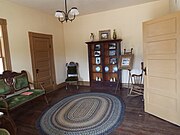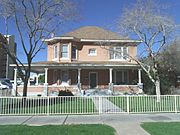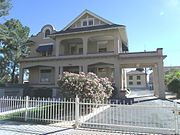List of historic properties in Phoenix

List of historic properties in Phoenix, Arizona | |
|---|---|
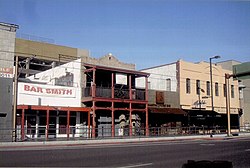 Historic Washington Street | |
 Location in Maricopa County and the state of Arizona |
| Part of a series of the |
| Cities, towns and CDPs in Arizona with lists and images of historic properties, forts, cemeteries or historic districts |
|---|
This is a list, which includes photographic galleries, of some of the remaining historic structures and monuments, of historic significance, in Phoenix, Arizona, United States. Included are photographs of properties identified by the African, Asian and Hispanic historic property surveys of the City of Phoenix, focusing on the themes of history in Phoenix from 1870 to 1975.
This list however, is not limited to historical structures and monuments. Also listed are historical landmarks, some of which are listed in the National Register of Historic Places such as the Pueblo Grande Ruin and Irrigation Sites and the Deer Valley Rock Art Center. These contain the ruins of structures and artifacts of the Hohokams who lived within the modern Phoenix city area before the arrival of the settlers of non-Native American origin.
The abandoned Joint Head Dam and the early canals built by the early pioneers of European descent played an important role in the irrigation and development of Phoenix and its surrounding areas. Pictured is the ruins of the abandoned Joint Head Dam built in 1884. Also, pictured is the Grand Canal, the oldest canal in Phoenix which was built by the pioneers in 1877, and the Old Crosscut Canal, built in 1888.
Included in this list are the photographs of the final resting place of various notable people who are interred in Phoenix's historic cemeteries who were of historical importance to Phoenix and Arizona. According to the definition by the "Pioneers' Cemetery Association (PCA)" a "historic cemetery" is one which has been in existence for more than fifty years. Among the cemeteries listed is the abandoned Crosscut Cemetery which was established in 1870 and therefore, Phoenix's oldest cemetery and the Pioneer and Military Memorial Park, which is listed in the National Register of Historic Places.
Listed are some museums in Phoenix with the images of artifacts of historical importance. Such is the case of the Phoenix Trolley Museum where the historic Trolley Car #116 is showcased. Among the museums are the Martin Auto Museum, which showcases automobiles from 1886 onward and the Musical Instrument Museum.
Laveen and the Sunnyslope District are listed separately because these were two areas whose citizens wanted to proclaim the areas as independent towns, but whose areas were instead merged into the city of Phoenix.
Phoenix[edit]

Phoenix is the capital, and largest city, of the U.S. state of Arizona.[1] Phoenix was incorporated as a city in 1881, after being founded in 1867 near the Salt River close to its confluence with the Gila River. The city has numerous historic properties which have been listed in the National Register of Historic Places. There are also 33 landmarks and attractions within Phoenix that are claimed to represent the best features of the city. These have been designated as "Phoenix Points of Pride"[2] and/or are listed in the Phoenix Historic Property Register. The Phoenix Historic Property Register, was established in 1986. It is the city's official listing of the historic and prehistoric properties that have been deemed worthy of preservation. Some of these properties are listed in both the National Register of Historic Places and in the Phoenix Historic Property Register.[3][4][5][6]
Historic Heritage Square is part of the Heritage and Science Park on the east end of downtown. It encompasses the only remaining group of residential structures from the original town site of Phoenix.[7] The images of these properties with a short description of the same are included.
Vanishing Phoenix[edit]

According to Robert A. Melikian, author of the book Vanishing Phoenix, Phoenix's preservation office does not have the ability to deny a demolition permit. Therefore, the owner of a property, listed either in the National Register of Historic Places or the Phoenix Historic Property Register, may demolish the historical property.[8] Entire neighborhoods, such as Golden Gate, where members of the minority communities lived have been razed. Both the residence of former Territorial Governor Joseph Kibbey located at 1334 E. Jefferson St. which served as the home and medical practice of Dr. Winston C. Hackett, the first African-American physician in Arizona and the building located at 1342 E. Jefferson St. where Hackett founded the Booker T. Washington Memorial Hospital were demolished.[9][10] The historic St. James Hotel is an example of a building listed in the National Register of Historic Places which will be demolished, despite the protests of preservation groups, to make way for a VIP parking lot for the Phoenix Suns season ticket holders. Among the properties which are listed in the National Register of Historic Places and which have been demolished are the following:[11]
- Arizona Citrus Growers Association Warehouse-601 E. Jackson Street.
- Concrete Block House – 618-620 N. 4th Avenue.
- Higuera Grocery – 923 S. 2nd Avenue.
- Lightning Delivery Co. Warehouse-425 E. Jackson Street.
- Overland Arizona Co. – 12 N. 4th Avenue.
- Judge W. H. Stillwell House – 2039 W. Monroe Street.
- Clinton Campbell House – 361 N. 4th Avenue.
Some of the historic houses and buildings which are listed in the National Register of Historic Places and/ or the Phoenix Historic Property Register are also listed in the "enDangered Dozen Historic Places List," released by the Phoenix Historic Neighborhoods Coalition. These structures are prone to vandalism and the elements. Among the structures which are neglected and are at the highest risk of disappearing in the near future are the following:[12]
- The Steinegger Lodge, built in 1889 and located at 27 E. Monroe St.
- The William R. Norton House, built in 1895 and located at 2222 W. Washington St.
- The Charles Pugh House, built in 1897 and located at 356 N. Second Avenue / 362 N. Second Avenue. (The 356 address is how the records show the house today. It was listed as 362 in older records.)
- The Louis Emerson House, built in 1902 and located at 623 N. Fourth St.
- The Concrete Block Bungalow, built in 1908 and located at 606 N. 9th St.
- The Leighton G. Knipe House, built in 1909 and located at 1025 N. 2nd Avenue.
- The Sach's-Webster Farmstead House, built in 1909 and located in the Northwest corner of 75th Avenue and Baseline.
- The Sarah Pemberton House, built in 1920 and located at 1121 N. 2nd St.
- Mrs. Neal House, built in 1920 and located at 102 East Willetta Street.
Pueblo Grande Ruin[edit]
The Pueblo Grande Ruin is the remains of a 450 BC prehistoric Hohokam village. For unknown reasons the site was abandoned by 1450 AD. These are some of the ruins of the Hohokam structures which were unearthed and which are situated in the Pueblo Grande Museum & Archaeological Park.
Listed in the National Register of Historic Places
- Pueblo Grande Ruin National Historic Landmark Marker. Marker and contents are the work of the US Dept. of the Interior, therefore PD.
- The Pueblo Grande Ruin Museum is located at 4619 E. Washington St. in Phoenix, Arizona. The ruins are listed in the National Register of Historic Places reference #66000184.
- Artifacts displayed inside the Pueblo Grande Ruin-Museum
- Display inside the Pueblo Grande Ruin Museum.
- Hohokam's of power and influence lived in houses surrounded by mounds.
- On the sunrise in the summer solstice and in the winter solstice an alignment occurs. A shaft of light stretches from one doorway to another, signaling the mid points of the solar annual cycle.
- Tools and weapons were stored in these rooms.
- These rooms were large and had eight foot walls. Artifacts were kept in them.
- Miller's Room was named after Dr. Joshua Miller, President of Arizona Antiquarian Association, who 1901 conducted the first excavation of the Pueblo Grande Ruins.
- This is the largest mound in the Pueblo Grande Ruin.
- This is a representation of what a Hohokam house looked like 700 years ago.
- Inside view of the Adobe Compound Replica.
- Artifacts inside of the Adobe Compound Replica.
- These replicas represent what the Hohokam pit houses looked like 1000 years ago.
- This was a Hohokam ballpark where they played ceremonial ball games. The villagers stood on top of the surrounding mound to observe the game.
- Made from mesquite, these kitchens were used by the O'odham people, believed to be descendants of the Hohokam, in the 1600s.
- The ovens was shared by the Hohokam community.
- Partial view of the Hohokam Village.
- Different view of the Hohokam Village.
- The Old Crosscut Canal was built in 1888 by the pioneers, adjacent to an ancient Hohokam canal which is now filled with soil.
The Joint Head Dam and canals[edit]
When the pioneers of European descent settled in Phoenix, the area was mainly desert. Settlers such as Jack Swilling were inspired by the ancient canals of the Hohokam. The pioneers soon began to dig ditches to carry water from the Salt River which would irrigate their farms. Eventually, canal building companies, such as the Arizona Canal Company, which was formed in December 1882, were organized and built the current canals in the area. The Joint Head Dam was built in 1884, where Jack Swilling dug his ditch, known as the "Swillings Ditch", and where the Salt River are located. The dam served the Grand Canal (built 1878) and eventually the Old Crosscut Canal (built 1888). The abandoned Joint Head Dam has been determined to be eligible for inclusion in the National Register of Historic Places under criterion "A" because of its association with the locally important history of reclamation and therefore, is a Section 4 (f) resource.[13]
- The ruins of the abandoned Joint Head Dam. The joint Head Dam was built in 1884 and repaired in 1913. It is located on a parcel owned by the City of Phoenix, just off 48th Street.
- The ruins of the abandoned Joint Head Dam.
- Joint Head Dam ruins.
- Ruins of the front side of the Joint Head Dam
- More ruins of the abandoned Joint Head Dam
- Ruins of the abandoned Joint Head Dam
- Dried up Salt River bed leading to the Joint Head Dam
- The dried up section of the Salt River where the abandoned remains of the head gate of the Joint Head Dam is located. This is where Jack Swilling first turned a shovel and established the head of "Swillings Ditch".
- Grand Canal built in 1878 in Phoenix.
- The overflow release on the Grand Canal. Built in 1878, it is located near the end of 48th Street on a parcel owned by the City of Phoenix.
- The other side of the overflow release on the Grand Canal
- Different view of the overflow release on the Grand Canal
- The Old Crosscut Canal built adjacent to the Pueblo Grande Ruin in Phoenix.
- The Old Crosscut Canal was built in 1888.
- Different view of the 1888 Old Crosscut Canal.
Heritage Square[edit]
Phoenix's Heritage Square is located in what once was block 14 of the original townsite of Phoenix. The square dates back to the Victorian era of the late 1800s. The townsite was listed in the National Register of Historic Places on November 7, 1978, reference: #78000550. The Dr. Roland Lee Rosson House (1895), now a Victorian-period historic house museum, and Baird Machine Shop (1920), which are individually listed in the National Register of Historic Places, are also located in the historic square.[14]
- The Dr. Roland Lee Rosson House was built in 1895 and is located in 139 N. 6th Street in Phoenix. It was added to the National Register of Historic Places in 1971. Reference #71000112
- The Rosson Carriage House was built in 1899 (PHPR)
- The Baird Machine Shop built in 1920. It is now part of Phoenix's Heritage Square. It was listed in the National Register of Historic Places in 1985. Reference number 85002047.
- The Hughe's-Stevens Duplex, built in 1923 (PHPR).
- The Forest Burgess Carriage House built in 1881 (PHPR)
- The Stevens House built in 1901 (PHPR)
- The Bouvier Teeter House built in 1899 (PHPR)
- The Thomas House was built in 1909. (PHPR)
- The Stevens-Haugsten House was built in 1901 (PHPR).
Buildings and structures[edit]
This section includes historical buildings which are listed either in the National Register of Historic Places or in the Phoenix Historic Property Register. The oldest of these, which is still standing and in use, is the "Fry's Building" which was built in 1885. The oldest hotel, which was completed in 1893, and is still in use today is the "Windsor Hotel".
Also, included in this section are historic structures such as the "Heard Ranch Grain Silos", listed in the PHPR plus, the Arizona State Fair Grandstand which was built in the early 1900s, the "17th Avenue Underpass" and the "Central Avenue Underpass", both which are eligible to be included in the National Register of Historic Places.[15]
(NRHP = National Register of Historic Places)
(PHPR = Phoenix Historic Property Register)
- What remains of the Phoenix Bakery building. The structure was built in 1881 and was originally located at 7 West Washington Street. The building was donated to the Pioneer Living History Museum in Phoenix. In 2019, the bakery was moved and reassembled at the Phoenix Zoo. [16]
- The Fry's Building was built in 1885 and is located in 146 E. Washington St. Listed in the National Register of Historic Places, reference: #85002056.
- The Steinegger Lodging House. The now abandoned structure was built in 1889 and listed in the National Register of Historic Places, reference: #86001369 on June 19, 1986. It was also known as the Alamo Hotel, St. Francis Hotel and the Golden West Hotel. It is located in 27 E. Monroe St. The Steinegger Lodging House was demolished on July 13, 2020.[17]
- The Phoenix Building and Loan house was built in 1890 and is located at 1138-40 East Taylor Street. It was listed in the National Register of Historic Places on January 12, 1995, reference: #94001534.
- The Windsor Hotel, originally known as the 6th Avenue Hotel, The hotel was completed in 1893 and is located at 546 W. Adams St. The hotel is listed in the National Register of Historic Places, reference: #85002041.
- This is the service desk of the historic Windsor Hotel, originally called the "6th Avenue Hotel".
- This is the lobby of the historic Windsor Hotel.
- The Phoenix Cotton Oil Company Building was built in 1895 and is located at 606 E. Grant St. in Phoenix, Az. It is listed in the Phoenix Historic Property Register.
- Historic Prescott and Eastern Railroad Depot built in 1898 in Mayer, Arizona. The building was purchased by a private citizen who had it hauled to a hill in Phoenix. The owner turned it into part of his home. It is located at 1711 N. 18th Place.[18]
- Arvizu's El Fresnal Grocery Store, also known as 25-23, was built in 1900 and is located at 310 E. Buchanan, Phoenix, Arizona. It was added to the National Register of Historic Places in 1985, reference: #85002046 (NRHP).
- Yaun Ah Gim Groceries was built in 1900 and is located at 1002 S. 4th Avenue. The building which is in a state of abandonment, was listed in the National Register of Historic Places on July 8, 1986, reference: #86001553 (NRHP).
- The Arizona State Hospital Building, also known as Mahoney Administration Building, was built in 1900 and is located at 2500 E. Van Buren St. It was listed in the National Register of Historic Places on July 15, 2009, reference #09000510.
- The Arizona State Capitol building was built in 1900 and is located at 1700 W. Washington. It was listed in the National Register of Historic Places on October 29, 1974, ref. #74000455.
- Phoenix Seed and Feed Warehouse built in 1905 and located at 411 S. Second St. It is the oldest warehouse in the original Phoenix town-site. Listed in the National Register of Historic Places, reference: #85002071
- The originalGreenwood Memorial Park Crematorium built in 1906. It is located on the grounds of the Greenwood/Memory Lawn Mortuary & Cemetery
- The Phoenix Carnegie Library was built in 1907 and is located at 1101 W. Washington St. The property is listed in the National Register of Historic Places.
- The Del Monte Market built in 1908 and located at 2659 W. Dobbins Road in South Mountain Village, an urban village within the city of Phoenix. It is the oldest continuously operating market in the state. Designated as a landmark with Historic Preservation-Landmark (HP-L) overlay zoning (Phoenix Historic Property Register).
- The Valley Machine Works built in 1909 and located in 701 West Jackson Street.
- Phoenix Volunteer Firefighters Monument built in 1910 and located on the grounds of the Greenwood/Memory Lawn Mortuary & Cemetery.
- The Gas Works building was built in 1910 and is located at 401 S. Second Avenue. It was listed in the Phoenix Historic Property Register in July 2000.
- The Swindall Tourist Inn was built in 1913 and is located at 1021 E. Washington St. Prior to 1964, public accommodations in Phoenix and Arizona were segregated. African Americans were not allowed to stay in the hotels in downtown Phoenix. The structure, which is listed in the National Register of Historic Places, reference: #95001081, is the only known surviving African-American boarding house in Phoenix.
- The Wakelin (E.S.) Grocery Company Warehouse was built in 1913 and is located in the corner of 219 S. Fifth Avenue / 440 W. Jackson St. It was listed in the Phoenix Historic Property Register in July 2000.
- The Jefferson Hotel was built in 1915 and is located at 101 S. Central Avenue in Phoenix. It is no longer a hotel and is called the Barrister Place Building. The building is owned by the city of Phoenix and is currently the home to the Phoenix Police Museum (Phoenix Historic Property Register).
- The Durand Grocery building was constructed in 1916 and is located at 901 W. Grand Avenue. The building was listed in the National Register of Historic Places on October 1, 1985, reference: #85002891.
- The Phoenix Elementary School District #1 Administration Building was built in 1917 and is located at 331 N. 1st Avenue. the building was listed in the Phoenix Historic Property Register in October 1996.
- The Luis Lugo Bakery, also known as "La Patellera", was built in 1917 and is located at 415 W. Sherman St. This structure is one of the earliest Hispanic commercial properties in Phoenix. Designated as a landmark with Historic Preservation-Landmark (HP-L) overlay zoning (Phoenix Historic Property Register).
- Different view of the Luis Lugo Bakery also known as "La Patellera".
- The two-story Southwest Cotton Co./Karlson Machine Works building was built in 1918 and is located at 104 E. Grant Street. Designated as a landmark with Historic Preservation-Landmark (HP-L) overlay zoning. Listed in the Phoenix Historic Property Register.
- The Gem and Mineral Building built in 1918 on the Arizona State Fairgrounds which is located at 1826 West McDowell Road. It is currently the oldest building there. Listed in the Phoenix Historic Property Register
- The side wall of the Gem and Mineral Building
- Close-up view of the Gem and Mineral Building
- Inside the Gem and Mineral Building
- The Tovrea Land and Cattle Co. Administration Building / Stockyards Restaurant is located at 5009 E. Washington St. In 1919, Edward A. Tovrea, the "Cattle Baron," opened his Phoenix packing house west of 48th Street and Van Buren to support his growing beef operations. The Tovrea Land and Cattle Co. had grown to nearly 40,000 head of cattle secured by 200 acres of cattle pens, making it the world's largest feedlot. In 1947, The Stockyards Restaurant officially opened and quickly became a favorite gathering place for cattlemen, bankers and politicians. Although cattle fortunes faded in the late 1950s and pens slowly gave way to urban growth, the popularity of Arizona's Original Steakhouse remained intact.[19] The property was listed in the Phoenix Historic Property Register in March 2004.
- J.W. Walker Building, also known as the Central Arizona Light and Power Building, was built in 1920. The building is located at 12th N. 4th Avenue. It was added to the National Register of Historic Places in 1985, reference: #85002077.
- Front view of the J.W. Walker Building.
- The Corpstein Duplex was built in 1920 and is located at 417 W. Roosevelt St. It was listed in the Phoenix Historic Property Register in September 1986.
- The Cole Mansion and Baker House were built in the 1920s and are located at 1418 N. Central Avenue in Phoenix. The Cole family purchased the Baker house and in 1940 connected both houses with a building in between. The structure has been occupied by the SpaghettI Factory Restaurant since 1996. It is listed on the Phoenix Historic Property Register.
- The Dr. Shackelford Dental Office Building which currently houses a small exhibit of the Arizona Street Railway Museum. Listed in the Phoenix Historic Property Register
- The Constable Ice and Fuel Co. building (now known as The Ice-house) was built in 1920 and is located at 429 W Jackson St. Before refrigeration ice was stored in this building. The Ice-house is located in the historic original townsite of the city of Phoenix. The building is now a cultural center devoted to promoting the Arts and humanitarian causes. Designated as a landmark with Historic Preservation-Landmark (HP-L) overlay zoning. The building was listed in the National Register of Historic Places September 4, 1985, reference: #85002074.
- The Heard Building was built in 1920 and is located at 112 N. Central Avenue. It was Phoenix's first skyscraper. The building, which was listed in the National Register of Historic Places on September 4, 1985, reference: #85002059, was featured in Alfred Hitchcocks 1960 film "Psycho".
- Rehbein Grocery built in 1920 and located in 1227-1231 Grand Avenue. Listed in the National Register of Historic Places, reference: #85002895
- El Zaribah Shrine Auditorium. now the Polly Rosenbaum Building, was built in 1921 and is located at 1502 W. Washington St. Listed in the National register of Historic Places on March 9, 1989.
- Arizona Compress and Warehouse Co. Warehouse built in 1922 and located at 215 S. 13th Street. On September 4, 1985, the property was listed in the National Register of Historic Places, reference: #85002044.
- Different view of the Arizona Compress and Warehouse Co. Warehouse which was built in 1922 and is located at 215 S. 13th Street. On September 4, 1985, the property was listed in the National Register of Historic Places, reference: #85002044
- The Chambers Storage Building was built 1923 and is located at 309 S. 4th Avenue. It was listed in the National Register of Historic Places on September 4, 1985, reference: #85002052.
- The Chambers Transfer and Storage Central Warehouse was built in 1923 and is located at15-39 E. Jackson St. It was listed in the National Register of Historic Places on September 4, 1985, reference: #85002051.
- The Phoenix Union Station was built in 1923 and is located at Fourth Avenue and Southern Pacific RR tracks, Phoenix, Arizona. It was listed in the National Register of Historic Places in 1985, reference: #85003056
- Different view of the historic Phoenix Union Station built in 1923 and located at 401 W. Harrison St. Listed in the National Register of Historic Places, reference number 85003056
- The Brickhouse Warehouse Building was built in 1924 and originally served as a warehouse. The structure is located at 1 East Jackson Street on the original town-site of Phoenix.[20]
- Different view of the Brickhouse Warehouse Building.
- The Luhrs Building is an historic ten-story building built in 1924. It is located at 11 West Jefferson in downtown Phoenix. Listed in the National Register of Historic Places
- The Wing F. Ong Grocery Store located at 1246 E. Jefferson St. and built in 1925. Wing F. Ong ran for the state House of Representatives as a Democrat in 1946 and was elected, the first Chinese American in the country to achieve such status. Over the course of his career, he was elected twice to the state House and once to the state Senate.
- The Hurley Building was built in 1925 and is located at 536 and 544-548 W. McDowell and 1601 N. 7th Avenue. It was listed in the National Register of Historic Places on September 4, 1985, reference: #85002062
- The Copeland & Trachet Service Station, now Granpa Sal's Tires, was built in 1925 and is located at 1702 W. Van Buren Rd. It was listed in the National Register of Historic Places on September 4, 1985, reference: #85002054.
- Bragg's Pie Building was built in 1925 and is located at located at 1301 Grand Avenue. The property was listed in the National Register of Historic Places on June 16, 2009.
- Front of Bragg's Pie Building.
- The Valley Plumbing and Sheet Metal Building was built in 1925 and is located at 530 W. Adams St. It was listed in the National Register of Historic Places on October 1, 1985, reference: #85002894.
- The Shell Oil Company Warehouse was built in 1925 and is located at 425 S. N. 16th Avenue. Listed in the National Register of Historic Places, reference: #85002073.
- Western Wholesale Drug Company Warehouse built in 1925 and located at 101 E. Jackson St. The structure is owned by rock legend Alice Cooper and now houses the Alice Cooperstown Restaurant. Designated as a landmark with Historic Preservation-Landmark (HP-L) overlay zoning (PHPR).
- The Security Building was built in 1925 and is located at 234 North Central Avenue. The property is listed in the National Register of Historic Places.
- The Anchor Manufacturing Co., also known as 41-3, was built in 1925. It is located at 525 (525-551) S. Central Avenue. The building was listed in the National Register of Historic Places in 1985, reference: #85002042.
- Different view of the Anchor Manufacturing Co.
- The San Carlos Hotel, also known as Hotel San Carlos, was built in 1925 and is located at 202 N. Central Avenue. Mae West, Clark Gable, Carole Lombard, Marilyn Monroe and Gene Autry are among the celebrities who at one time stayed at the San Carlos. The hotel was listed in the National Register of Historic Places in 1983. Reference number 83003498.
- The Firestone building built in 1925 and located at 302 W. Van Buren Avenue. The property was listed in the National Register of Historic Places on October 1, 1985, reference: #85002891.
- The Pay n Takit #13 was built in 1925 and located at 1402 E. Van Buren Rd. It was listed in the National Register of Historic Places in 1985, reference: #85002068.
- The Verde Park Pumphouse was built in 1925 and is located at Junction of 9th St. and Van Buren Avenue. It was listed in the National Register of Historic Places on September 7, 1995 reference #95001078. Area of Significance: Community Planning And Development; Period of Significance: 1925-1949.
- The Arizona Sash, Door & Glass Company Warehouse was built in 1926 and is located on 850 W. Lincoln St. It was listed in the Phoenix Historic Propeerty Register in February 2020.
- Hotel St. James. The now abandoned structure was built in 1925 and listed in the National Register of Historic Places, reference: #85002061 on September 4, 1985. The building which was located in 21 E. Madison St. was demolished in 2012.
- Mobile Gas Station built in 1926 and located at 1301 West Jefferson Street. It now houses "The Old Station Subs".
- The Phoenix Masonic Temple was built in 1926 and is located at 345 W Monroe St. Listed in the Phoenix Historic Property Register.
- The Pay'n Takit No. 25 was built in 1926 and is located at 1753-1755 W. Van Buren. The building was listed in the National Register of Historic Places on September 5, 1985, reference: #85002070. as of 2012 it house the Central United "A boxing club".
- The A.E. England Motors Building was built in 1926 and is located at 424 N. Central Avenue. Listed in the Phoenix Historic Property Register.
- J.T. Whitney Funeral Chapel built in 1926 and located at 330 N. Second Avenue. It was once the house of mortician J.T. Whitney. Listed in the National Register of Historic Places, reference: #85002079.
- The Welnick Arcade Grocery Store building was built in 1927 and is located at 324 Van Buren Street. The building was listed in the National Register of Historic Places on August 9, 2016, reference: #16000490.[20]
- An ornament on the Welnick Arcade Grocery Store building.
- The Pay n Takit #5 was built in 1927 and is located at 1012 N. 7th Avenue. It was listed in the National Register of Historic Places in 1985, reference: #85002069.
- The Barbara Jean Apartments was built in 1927 and is located at 212-214 E. Portland St. It was Listed in the Phoenix Historic Property Register in September 2004.
- The Blake, Moffitt, Towne Janitorial Co. Warehouse built in 1927 and located at 101 E. Buchanan St. Designated as a landmark with Historic Preservation-Landmark (HP-L) overlay zoning. Listed in the Phoenix Historic Property Register.
- The C. P. Stephans De Soto Six Motor Cars building was built in 1927 and is located at 915 S. Central Avenue. On February 20, 2013, the property was listed in the National Register of Historic Places, reference: #13000019.
- The Gold Spot Shopping Center built in 1925 and located at 1001 N. 3rd Avenue. The building served as a Shopping Center and Grocery from 1925 to 1983. Now serves as a Marketing Center. The building is in the Roosevelt Historic District which was listed in the National Register of Historic Places on November 30, 1983, reference #83003490.[21]
- Different view of the Gold Spot Shopping Center.
- The Arizona Museum building was built in 1927 and is located on the grounds of University Park at 1002 W. Van Buren St. The building was listed in the Phoenix Historic Property Register in April 1989.
- The Orpheum Theatre was built in 1927 and is located at 209 W. Adams Avenue. It was listed in the National Register of Historic Places on October 1, 1985, reference: #85002067.
- Orpheum Theatre ornament.
- Knights of Pythias Building built in 1928 and located in 146 E. Washington St. Listed in the National Register of Historic Places, reference: #85002063.
- Front entrance of the Knights of Pythias Building.
- J.B. Bayless Store No. 7 built in 1928 and located at 825 N. Seventh St. Listed in the National Register of Historic Places, reference: #85002048
- Central Arizona Light & Power Co. Warehouse built in 1928 and located at 501 S. Third Avenue. Designated as a landmark with Historic Preservation-Landmark (HP-L) overlay zoning. Listed in the Phoenix Historic Property Register.
- Historic Old Phoenix City Hall built in 1928 and located at 17 S. Second Avenue. This structure served as the Phoenix's City Hall until 1994 when the a new building was completed to serve as such. Designated as a landmark with Historic Preservation-Landmark (HP-L) overlay zoning. Listed in the Phoenix Historic Property Register.
- Maricopa County Courthouse built in 1928. In this court house the trial of infamous Winnie Ruth Judd, a.k.a. "The Trunk Murderess", was held. The historic "Miranda rights" were established in this court after the arrest of Ernesto Miranda. Both Judd and Miranda were incarcerated in the jail located on the sixth floor. Listed in the National Register of Historic Places.
- Maricopa County Jail where Judd and Miranda were once incarcerated.
- The 1931 Jack and Trinidad Swilling plaque on the water fountain in front of the historic Maricopa County Courthouse
- Gerardo's Building built in 1928 and located at 421 S. Third St. It once housed a café on the first floor and residential rentals on the upper level. Listed in the National Register of Historic Places, reference: #85002057.
- Jim Ong's Market built in 1928 and located at 1110 E. Washington St. The structure, one of two built by the owner in the Chinese Community, also served as the home of the Ong family. Listed in the National Register of Historic Places, reference: #82002084.
- The Stapley (O.S.) Company Building was built in 1928 and is located at 723-735 Grand Avenue. The property was listed in the National Register of Historic Places in September 2012.
- The Fuller (W.P.) Paint Company Warehouse was built in 1929 and is located at 117 E. Jackson St. The property was listed in the Phoenix Historic Property Register in July 2009.
- The Phoenix Linen & Towel Supply Company Warehouse was built in 1929 and is located at 702-706 S. Third St. / 215 E. Grant St. The property was listed in the Phoenix Historic Property Register in February 2010.
- Brown's Pharmacy was built in 1929 and is located at 1000 E. Pierce Street. It was listed in the National Register of Historic Places on September 4, 1985, reference: #85002949.
- Luhrs Tower built in 1929 and located at 45 W. Jefferson St. The Luhrs Tower appeared in the background of a scene from the 1960 film Psycho in which the character Marion Crane (played by Janet Leigh) crossed the street with the deposit she was supposed to make for her boss. Listed in the National Register of Historic Places, reference: #85003559
- The Sun Mercantile Building was built in 1929 and is located at 232 S. 3rd Avenue. It is the last remaining warehouse in what was once Phoenix's Chinatown. Listed in the National Register of Historic Places, reference: #85003075.
- The Santa Fe Freight Depot was built in 1929 and is located at 5th Avenue and Jackson Street. Listed in the Phoenix Historic Property Register.
- The front entrance of the Heard Museum building which was built in 1929 and is located at 2301 N. Central Avenue / 22 E. Monte Vista Road. It was listed in the Phoenix Historic Property Register in August 1992.
- The Heard Museum building was built in 1929 and is located at 2301 N. Central Avenue / 22 E. Monte Vista Road. Maie Heard added quality artworks to the collection and worked closely with the board of trustees to direct the activities of the museum. She also oversaw the programming activities of the museum, approving speakers and insuring appropriate publicity was available. It was listed in the Phoenix Historic Property Register in August 1992.
- The Heard Ranch Grain Silos were built in 1930 and are located within the golf course of the Legacy Resort in the vicinity of 30th Street and Vineyard Road. The ranch belonged to businessman Dwight B. Heard, who is given much of the credit for the Arizona Republic newspaper (of which he was publisher), the Heard Museum and the development of the vital irrigation canals and the Arizona cattle industry. The property was listed in the Phoenix Historic Property Register in March 1993.
- In the 1930s this was a Phoenix Airport hangar and terminal where in 1933, Ruth Reinhold became the first female pilot in Arizona.
- The Greystone Apartments was built in 1930 and is located at 645-649 N. Fourth Avenue. It was listed in the Phoenix Historic Property Register in September 1986.
- Different view of the Greystone Apartments which were built in 1930 and is located at 645-649 N. Fourth Avenue. It was listed in the Phoenix Historic Property Register in September 1986.
- The General Electric Supply Warehouse was built in 1930 and is located at 435-441 W. Madison St. The property was listed in the Phoenix Historic Property Register in July 2000.
- Department of Agriculture Building built in 1930 and located at 1688 West Adams. Listed in the Phoenix Historic Property Register.
- The Arizona State Fair Grandstand was built in the early 1900s and is located at 1826 West McDowell Road.
- Different view of the Arizona State Fair Grandstand which was built in the early 1900s and is located at 1826 West McDowell Road.
- The Ong Yut Geong Market Warehouse was built in 1930 and is located at 502 S. 2nd. St. Listed in the National Register of Historic Places, reference: #86002066 (NRHP).
- Arizona Hardware Supply Company Warehouse was built in 1930 and is located at 22 E. Jackson St. Designated as a landmark with Historic Preservation-Landmark (HP-L) overlay zoning. Listed in the Phoenix Historic Property Register.
- The Bobby Brown Café building was built in 1930 and is located at 1714-18 W. Van Buren Avenue. This property was listed in the Phoenix Historic Property Register.
- The Wakelin (E.S.) Grocery Company Warehouse was built in 1930 and is located in the corner of 219 S. Fifth Avenue / 440 W. Jackson St. It was listed in the Phoenix Historic Property Register in July 2000.
- This location which once housed the Living Room Lounge was built in 1930 and is located at 4007 E. Camelback Road in Phoenix. The building housed the Silver Poodle Cocktail Lounge prior to 1968, when boxing welterweight Tony DeMarco became the owner of the property and established what he called the Living Room Lounge. DeMarco no longer owns the property which now belongs to the U-Haul Co.[22]
- The Day (Dud R.) Motor Company/Phoenix Motor Company building was built in 1930 and is located at 401 West Van Buren Street. It was listed in the Phoenix Historic Property Register in May 2017.
- The Wastewater Treatment Plant Control Building was built in 1931 and is located at 2301 W. Durango St. The structure is now within the confines of the Arizona Department of Transportation District whose address is 2140 W. Hilton. It was listed in the Phoenix Historic Property Register in October 1992.
- The Stag Hotel / Patio Hotel was built in 1931 and is located at 27 W. Madison St. It now houses a Chinese Restaurant. It was listed in the Phoenix Historic Property Register in October 2001.
- The "U" shaped Phoenix Title and Trust Towers were built in 1931 and are located at 112 N. 1st. Avenue. The towers were listed in the National Register of Historic Places on September 4, 1985, reference: #85002076.
- Entrance of the Lois Grunow Memorial Clinic, built in 1931 and located at 926 E. McDowell Rd. On September 4, 1985, the property was listed in the National Register of Historic Places, reference: #85002065.
- The Professional Building built in 1931 and located at 137 N. Central Avenue. It was listed in the National Register of Historic Places in 1993, reference: #85003563.
- The U.S. Post Office / Federal Building was built 1932–1936 and is located at 522 N. Central Avenue. The building was listed in the Historic Properties in Phoenix Register in October 1990. It was listed in the National Register of Historic Places on February 10, 1983, reference #83002993.
- The Cobb Bros. Market Warehouse built in 1932 and located at 430 S. Second Avenue. Designated as a landmark with Historic Preservation-Landmark (HP-L) overlay zoning. Listed in the Phoenix Historic Property Register.
- The University Park Bath (Pool) House was built in 1934 and is located on the grounds of University Park at 1002 W. Van Buren St. The building was listed in the Phoenix Historic Property Register in April 1989.
- The 17th Avenue Underpass built in 1935 is a well-preserved example of Depression-era bridge construction. It is eligible for inclusion in the National Register of Historic Places.
- The Encanto Park Clubhouse was built in 1936 and is located at 1202 W Encanto Blvd. Listed in the Phoenix Historic Property Register.
- The Arizona Army National Guard Arsenal raw adobe building was constructed in 1936 and is located at 5636 E. McDowell Rd. It served as the National Guard arsenal building until WW II when it was converted into a maintenance shop for the German prisoners of war who were held in a camp located in what is now the Papago Park Military Reservation. The building now houses the Arizona Military Museum. The building was listed in the National Register of Historic Places March 31, 2010, reference: #10000108.
- The original adobe walls inside the Arizona Army National Guard Arsenal building.
- The Hunt Bass Hatchery Caretaker's House was built in 1936 and is located in the Phoenix Zoo grounds at 455 N. Galvin Parkway. Following the Great Depression, Governor Hunt (Arizona's first elected governor) commissioned a bass fish hatchery to be established in the Papago Park of Arizona during 1932. The property was listed in the National Register of Historic Places on January 23, 2003, reference: #02001723.
- The Neighborhood House was built in 1937 and is located at 6029 S. Seventh St. It was listed in the Phoenix Historic Property Register in May 1990.
- The Merryman Funeral Home was built in 1937 and is located at 817 N. First St. The property was listed in the Phoenix Historic Property Register in November 2005.
- The Squaw Peak Inn was built in 1937 and is located at 4425 Horseshoe Road close to the east end of Squaw Peak Mountain in Phoenix. Among celebrities who have stayed in or visited the Inn, which was originally named Squaw Peak Ranch, are Dick Powell, June Allyson and Mamie Eisenhower. It served as the vocal point for the 1987 made-for-TV movie Probe: Plan Nine from Outer Space. The Inn was used as a backdrop during the interview made to Phoenix Suns Charles Barkley by ABC's prime Time Live on May 27, 1993. On January 12, 1995, the property was listed in the National Register of Historic Places, reference: #94001537.
- King's Rest Hotel Motor Court was built in 1937 and is located at 801 S. 17th Avenue. Listed in the National Register of Historic Places, reference: #87001882.
- This motel started as the Arrow Motel and later became the Rainbow Motel. It was built in 1937 and is located on 2262 Grand Avenue. The property was listed in the Phoenix Historic Property in October 2020.
- The Arizona State Fair WPA Civic Building was built during the Great Depression Era in 1938 and is located at 1826 West McDowell Road.
- The front entrance of the Arizona State Fair WPA Civic Building, which was built during the Great Depression Era in 1938. It is located at 1826 West McDowell Road.
- The Webster Auditorium building was constructed in 1939 and is located inside the compounds of the Desert Botanical Garden at 1201 N. Galvin Parkway. The auditorium is named after Gertrude Webster. On June 13, 1990, the National Park Service certified Webster Auditorium as a national historic site. It was listed in the National Register of Historic Places on May 1, 1990, reference: #9000823.
- Inside the Webster Auditorium.
- The Arizona State Fair Home Economics Building was built in 1940 on the Arizona State Fairgrounds and is in danger of being demolished.
- Close up view of the Arizona State Fair Home Economics Building.
- The only remaining courtyard of the Matthew Henson Public Housing Project with the original houses which have been preserved from demolition. The housing project was built in 1940 and provided affordable housing for the African-American community. The Matthew Henson Public Housing Project district is located on the west side of Seventh Avenue just south of the Sherman Street alignment. It was named as a historic district by the Phoenix Historic Property Register in June 2005.
- The Central Avenue Underpass was built in 1940 and is located on Central Avenue just south of Madison Street in downtown Phoenix. The above bridge was originally built for the ATSF railway. It was listed in the Phoenix Historic Property Register.
- The Crippled Children's Hospital was built in 1041 and is located at 1825 E. Garfield St. It was listed in the Phoenix Historic Property Register in September 2020.
- The Phoenix Housing Authority Building was built in 1941 and located at 1301 – 1305 1301 S. Third Avenue. It was listed in the Phoenix Historic Property Register in October 2007.
- The Good Shepherd Home for Girls structure was built in 1942 and is located near the northeast corner of Northern and 19th Avenues. The home for girls closed in 1981 and is now a commercial property. The owners have kept the main architectural features intact. Designated as a landmark with Historic Preservation-Landmark (HP-L) overlay zoning. It was listed in the Phoenix Historic Property Register
- The Pohle Dry Cleaning Building was built in 1946. It is located at 3233 E. Van Buren Street. The style of the building at the time was a progressive international style. The building is considered historical by the Phoenix Historic Preservation Office.
- The General Sales Co. building was built in 1946. It is located at 515 E. Grant St. The builders combined the Classicism with the feeling of Organicism styles. The building was listed in the National Register of Historic Places on October 4, 2016, reference: #16000681.
- Hanny's, also known as 29-22, was built in 1947 and is located at 44 N. 1st. street. It was added to the National Register of Historic Places in 1985, reference: #85002058.
- The Graham Paper Company Warehouse was built in 1949 and is located at 521 S. Third St. / 310 E. Lincoln St. It was listed in the Phoenix Historic Property Register in July 2009.
- The Medical Center building was built in 1949. The property now houses Summit Elementary School. It is located at 1313 N. 2nd Street. The building is considered historical by the Phoenix Historic Preservation Office.
- The Farmers & Stockmens Bank was built in 1950–1951 and is located at 5001 E. Washington St. It was listed in the Phoenix Historic Property Register in October 2004.
- The original Sky Harbor Air Traffic Control Tower was built in 1952 along with Terminal 1. Terminal 1 was demolished in 1991 and the truncated iconic control tower was moved to 2768 East Old Tower Road, where it is currently located.[23]
- Close up view of the original Sky Harbor Air Traffic Control Tower.
- The Progressive Builders Association Building was built in 1953 and is located at 2019 E. Broadway Road. The Progressive Builders Association built homes in downtown Phoenix, giving many African Americans their first opportunity to buy a brand-new home. In 1945, members of the community met at the First Institutional Baptist Church and formed the Progressive Builders Association. It was listed as historic by the Phoenix African-American Survey and listed in the Phoenix Historic Property Register in June 2005.
- The Crown Filter Queen Building was built in 1955. It is located at 1800 W. Van Buren Avenue. The builders used clay brick and ashler sandstone. The building is listed in the National Register of Historic Places on July 10, 1992, reference #92000847, as part of the Oakland Historic District.
- The Produce Center Building was builtin 1956 and is located at 2202 W. McDowell Road. It was listed in the Phoenix Historic Property Register in October 2020.
- The Paris Laundry and Dry Cleaning Building was built in 1957. It is located 4130 N. 7h Avenue. This building was designed Googie style. Googie architecture is a form of modern architecture influenced by the Space Age and the Atomic Age. The building is considered historical by the Phoenix Historic Preservation Office.
- The Phoenix Towers were built in 1957 and are located at 2201 N. Central Avenue. Phoenix Towers was built as a resident-owned cooperative community, Phoenix Towers is now considered an outstanding example of mid-century architecture and was listed in the National Register of Historic Places on January 2, 2008, reference #07001334.
- Front view of the Phoenix Towers. The towers were built in 1957 and are located at 2201 N. Central Avenue. Phoenix Towers was built as a resident-owned cooperative community, Phoenix Towers is now considered an outstanding example of mid-century architecture and was listed in the National Register of Historic Places on January 2, 2008, reference #07001334.
- The Sacred Heart House for the Aged was built in 1958 and is located at 1110 N. 16th Street. On February 2, 2010, the building was listed in the National Register of Historic Places, reference: #05001548.
- The 300 Bowl building, which now houses the AMF Christown Lanes, was built in 1960. It is located 1911 W. Bethany Home Road. The three point roofline pegs this building as Googie architecture in style. Googie architecture is a form of modern architecture influenced by the Space Age, and the Atomic Age. The building is considered historical by the Phoenix Historic Preservation Office.
- Different view of the 300 Bowl building.
- The Conn and Candlin CPA Office was built in 1962. It is located at 2701 N. 7th Avenue. On January 9, 1991, the building was listed in the National Register of Historic Places, reference #90002099, as part of the Willo Historic District.
- Side view of the Conn and Candlin CPA Office.
- The Roman Roads built in 1962 and located at 1691 E Maryland Avenue. It was listed in the National Register of Historic Places on November 21, 2018, reference #100003124.
- The Roman Roads
- The Executive Towers were built in 1962 and are located at 207 West Clarendon Street. It was listed in the National Register of Historic Places on January 17, 2017, reference # 100000455.
- The Phoenix Star Theatre a.k.a. Celebrity Theatre was built in 1963 and is located 440 N. 32nd St. It was listed in the Phoenix Historic Property Register in September 2013.
- The Regency House was built in 1964 and is located at 2323 North Central Avenue. It was listed in the National Register of Historic Places on September 26, 2016, reference # 16000630.
- Arizona Veterans Memorial Coliseum built in 1965 and located at and located at 1826 W. McDowell Road. The coliseum served as the home of the Phoenix Suns from 1968 to 1992. The Monkees performed there in 1967 and so did Elvis Presley in 1970 and 73.[24]
- Different view of the Arizona Veterans Memorial Coliseum. On February 2, 1980, boxing Hall of Famer, Salvador Sanchez won the WBC World featherweight title when he beat Danny Lopez. Both Pope John Paul II (Sept. 14, 1987) and Mother Teresa (1989) made appearances there. Among the U.S. presidents that have visited the coliseum are Richard Nixon and Barack Obama.[24]
- The Valley National Bank building was built in 1968 and is located at 4401 E. Camelback Road in Phoenix. The building was designed by Frank Henry. It is listed in the Phoenix Historic Property Register.
- Different view of the Valley National Bank.
- Side view of the Valley National Bank.
- The Vlassis Ruzow and Associates Building was built in 1974. It is located at 1545 W. Thomas Road. The structure is listed in the National Register of Historic Places on April 12, 2007, reference #07000279, as part of the Margarita Historic District.
- Western Savings & Loan Building. The vase-like shaped building was built in 1975 and is located at 10005 South Metro Parkway. It is listed as historic by the Phoenix Historic Property Register.
- Inside view of the curved roof of the Western Savings & Loan Building.
Houses of religious worship[edit]
Many of the historic houses of religious worship, such as the "First Presbyterian Church" (1892), are listed in the National Register of Historic Places. Others, such as the "Tanner Chapel A.M.E. Church" (1929), have been designated historic by the Phoenix Historic Property Register. The Tanner Chapel A.M.E. Church, one of the oldest African-American churches in the state, is the only Arizona church where civil rights leader Martin Luther King Jr. is known to have given a sermon. Houses of religious worship such as the "First Mexican Baptist Church" (1920), Phoenix's oldest Hispanic church, are recognized as historic by surveys, as in the case of the Hispanic American Historic Property Survey of the City of Phoenix.
(NRHP = National Register of Historic Places)
(PHPR = Phoenix Historic Property Register)
- The First Presbyterian Church was built in 1892 and is located at 402 W. Monroe St. The property is listed in the National Register of Historic Places.
- The Sacred Heart Church was built in 1900 and is located in 920 S. 17th Street. It was added to the National Register of Historic Places March 20, 2012. Reference number 12000124.
- The Brooks Memorial United Methodist Church was built in 1908 and is located on 5921 West Thomas Road. Since 1985, the old church has been used as a funeral home.[25]
- The Saint Mary's Basilica was built in 1914 and is located at 231 N. 3rd. Street. It was listed in the National Register of Historic Places on November 29, 1978, ref. #78000551.
- The Trinity Episcopal Cathedral was built in 1915 and is located at 100 W Roosevelt Street. It is listed in the Phoenix Historic Property Register.
- The First Mexican Baptist Church was built in 1920 and is located at 1002 E. Jefferson Avenue. It is Phoenix's oldest Hispanic church. This property is recognized as historic by the Hispanic American Historic Property Survey of the City of Phoenix.
- The Temple Beth Israel (1922)/ First Chinese Baptist Church (1957)/ Iglesia Bautista Central (1981) was built in 1922 and is located at 122 E. Culver Street. It was Phoenix's first synagogue and the building later served as Phoenix's First Chinese Baptist Church and from 1981 to 2002, the Hispanic community as the Iglesia Bautista Central. It was listed in the National Register of Historic Places on February 22, 2011, reference #11000043.
- The First Baptist Church was built in 1923 and is located at 302 W. Monroe Street. The First Baptist Church is an Italian Gothic design by Phoenix architectural firm Fitzhugh & Byron. It was badly damaged by fire in 1980 and has been abandoned since. the structure is listed in the National Register of Historic Places.
- The Shiloh Baptist Church was built in 1924 and is located at 901 W. Buckeye Road. This is one of the earliest African-American churches in the West side of Phoenix. It is listed in the African American Historic Property Survey of the City of Phoenix.
- The Roosevelt Community Church was built in 1925 and was originally called the "First Church of Christ Scientist". It is located at 924 N. 1st Street and was listed in the National Register of Historic Places on August 10, 1993, reference #93000745.
- The Phoenix LDS Second Ward Church was built in 1929, and is the oldest LDS chapel in Phoenix. It was used by the "Phoenix Arts Council" for several years before being sold to the "Great Arizona Puppet Theater" in 1996. The building is located at 302 W Latham Street. It was added to the "National Register of Historic Places" in 1983. Reference number 83003492.
- The Bethlehem Baptist Church was built in 1925 and is located at 1402 E. Adams Street. It was listed in the National Register of Historic Places in 1993, ref.: #93000744.
- The Garfield Methodist Church was built in 1926 and is located at 1302 E. Roosevelt Street. It was listed in the National Register of Historic Places on August 10, 1993, reference #93000743.
- The First Missionary Church was built in 1928 and is located at 902 E. McKinley in Phoenix's historic Garfield neighborhood. The architecture of the structure is that of Mission Revival. It is designated as a landmark by the Historic Preservation-Landmark (HP-L) overlay zoning. It is listed in the Phoenix Historic Property Register.
- The Brophy College Chapel was built in 1928 and is located at 4701 N. Central Avenue. The Chapel was donated by Mrs. William Henry Brophy in memory of her husband. The Spanish Colonial chapel was built by the students of Brophy College. It was listed in the National Register of Historic Places on August 10, 1993, reference #93000747.
- The Grace Lutheran Church was built in 1928 and is located at 1124 N. 3rd Street. It was added to the National Register of Historic Places in 1993, Reference number 93000835.
- The Immaculate Heart of Mary Catholic Church was built in 1928 and is located at 909 E. Washington Street. It is Phoenix’ second oldest Hispanic church. The church was listed in the National Register of Historic Places on October 8, 1993, ref. number 93000742 (NRHP).
- The Tanner Chapel A.M.E. Church, named after Bishop Benjamin T. Tanner, was built in 1929 and is located at 20 S. 8th Avenue. it is the oldest African-American congregation in Arizona. Designated as a landmark with Historic Preservation-Landmark (HP-L) overlay zoning. It is listed in the Phoenix Historic Property Register.
- The Arizona Buddhist Temple built in 1930 and located at 4142 West Clarendon Avenue was the first church if its kind in Arizona.
- The St. Pius X Catholic Church was built in 1935 and is located at 802-815 South 7th Avenue. The church is listed in the Phoenix Historic Property Register.
- The Mennonite Church Meetinghouse was built in 1946 at 9835 N. 7th Street in what was then Sunnyslope. Sunnyslope later became part of Phoenix. In 1949, a new church was erected beside it. The older building was then used as a Christian day school and Sunday school. The church is listed in the Phoenix Historic Property Register.
- The South Mountain Community Church was built 1944 and is located 717 E Southern Avenue. It was listed in the Phoenix Historic Property Register in July 1993.
- The Mount Calvary Baptist Church was built in 1944 and is located at 998 South 13th Avenue. It is one of the earliest churches to serve the Phoenix Afro-American community. It is listed in the African American Historic Property Survey of the City of Phoenix.
- The Faith Lutheran Church was built in 1946 and is located at 801 E. Camelback Road. It is listed in the Phoenix Historic Property Register.
- The Primera Iglesia Metodista (First Methodist Church) was built in 1947 and is located at 701 S. 1st Street. This property is recognized as historic by the Hispanic American Historic Property Survey of the City of Phoenix.
- The Lucy Phillips Memorial C.M.E. Church was built in 1947 and is located at 1401 E. Adams Street. The church was built by the African-American community in Phoenix. It was named Lucy Phillips Memorial C.M.E. Church in honor of the wife of the first presiding bishop, the Rev. Charles Henry Phillips. The church was listed in the Phoenix Historic Property Register in June 2005.
- The St. Anthony Church was built in 1948 and is located at 909 S. 1st Street. This property is recognized as historic by the Hispanic American Historic Property Survey of the City of Phoenix.
- The Sunnyslope Presbyterian Church was founded in 1927 in Sunnyslope. The structure was built in 1949 and is located at 9317 N 2nd Street, in the Sunnyslope District of Phoenix. The church is listed in the Phoenix Historic Property Register.
- The building which once housed the historic Iglesia Betania Presbiteriana was constructed in 1950. It is located at 301 W Pima in Phoenix. This property is recognized as historic by the Hispanic American Historic Property Survey.
- The Pavilion of Light of the Phoenix First Assembly of God, or simply "Phoenix First", is an Assemblies of God megachurch. The structure was built in the 1980s and is located at 13613 N. Cave Creek Road. As of 2011, it was the second largest Assembly of God church in the U.S. with an average Sunday attendance of 10,000.
Educational institutions[edit]
The first school in Phoenix was established in 1873. It was known as the Little Adobe School and it was located in 202 N. Central Avenue where the San Carlos Hotel currently stands. Schools were segregated then and therefore, so were many of the historic schools on this list. The Phoenix Indian School was established in 1891 under the federal "assimilation" policy which sought to regimentalize and culturally exterminate Native American students.[26] African-American students were only allowed to attend racially segregated schools such as the Dunbar School which was built in 1925, the Phoenix Union Colored High School (Later renamed George Washington Carver High School) built in 1926, and the Booker T. Washington Elementary School built in 1928.
(NRHP = National Register of Historic Places)
(PHPR = Phoenix Historic Property Register)
- The Phoenix Indian School main building was built in 1891 and is located at 300 E. Indian School Rd. It was listed in the National Register of Historic Places on May 31, 2001, ref. #01000521.
- Different view of the Phoenix Indian School, located in the compounds of Phoenix's Steele Park in 300 E. Indian School Rd.
- Phoenix Union High School was built in 1912 and is located at 512 E. Van Buren. It was listed in the National Register of Historic Places on July 15, 1982, ref. #82002085.
- Phoenix Union High School Domestic Arts building was built in 1912 and is located at 512 E. Van Buren. It was listed in the National Register of Historic Places on July 15, 1982, ref. #82002085.
- Phoenix Union High School Auditorium was built in 1912 and is located at 512 E. Van Buren. It was listed in the National Register of Historic Places on July 15, 1982, ref. #82002085.
- Phoenix Union High School Science building was built in 1912 and is located at 512 E. Van Buren. It was listed in the National Register of Historic Places on July 15, 1982, ref. #82002085.
- Monroe High School was built in 1914 and is located at 215 N. 7th St. It was listed in the National Register of Historic Places on August 26, 1977, ref. #77000237.
- The Phoenix Elementary School District #1 Administration Building was built in 1917 and is located at 331 N. 1st Avemue. the building was listed in the Phoenix Historic Property Register in October 1996.
- The McKinley School was built in 1919 and is located at 512 E. Pierce St. The property was listed in the Phoenix Historic Property Register in September 2004.
- The Kenilworth School was built in 1919 and is located at 1210 N. 5th Avenue. It was listed in the National Register of Historic Places on March 25, 1982, reference #82002083.
- The current Cartwright School was built in 1921 and is located at 5833 W. Thomas Rd. It was listed in the National Register of Historic Places on August 12, 1993, ref. #93000739.
- The first Cartwright one-room school house was built in 1910. This is the original 1910 Cartwright School bell.
- Phoenix Indian School Memorial Hall was built in 1922 and is located at 300 E. Indian School Rd. It was listed in the National Register of Historic Places on May 31, 2001, ref. #01000521.
- Adams School (now Grace Court School) was built in 1924 and located at 800 W. Adams St. It was listed in the National Register of Historic Places on November 29, 1979, ref. #79000418.
- Franklin High School was built in 1925 and is located at 1625 W. McDowell Rd. It was listed in the National Register of Historic Places on August 12, 1993, reference: #93000814.
- Dunbar School was built in 1925 and is located at 707 W. Grant St. It was listed in the National Register of Historic Places on August 12, 1993, ref. #93000740.
- Phoenix Union Colored High School (Later renamed George Washington Carver High School) was built in 1926 and is located at 415 E. Grant St. It was listed in the National Register of Historic Places on May 2, 1991, ref. #91000543.
- The Booker T. Washington Elementary School was built in 1928 and is located at 1201 E. Jefferson St. The school was the first all African-American elementary school in Phoenix. It now houses the "Sun Times" of Phoenix. It is listed in the Phoenix Historic Property Register.
- The Arizona Academy North and South Halls were built in 1928 and are located at 1325 N. 14th Street. The former academy is now known as the Stepping Stone Place. The North Hall is addressed as 1307 and the South Hall as 1305. Both towers were listed in the National Register of Historic Places in 1993, ref.: #93000813.
- The John G. Whittier School was built in 1929 and is located at 2004 N. 16th Street. On August 12, 1993, it was listed in the National Register of Historic Places, ref.: #93000741.
- The Indian School Band Building built in 1931 and located in the compounds of Phoenix's Steele Park in 300 E. Indian School Rd. It was listed in the National Register of Historic Places on May 31, 2001, ref. #01000521.
- North Phoenix High School, now North High School (1954), was built in 1939 and is located on 1101 East Thomas Road. This is the original building which was planned and financed through the New Deal Works Projects Administration and Public Administration funds.[27]
19th century historic houses[edit]
Some of these houses meet the National Register criteria for evaluation. The quality of significance in American history, architecture, archeology, engineering, and culture is present in districts, sites, buildings, structures, and objects that possess integrity of location, design, setting, materials, workmanship, feeling, and association and that are associated with the lives of persons significant in Phoenix's past. The following prominent people who at one time or another lived in Phoenix and whose houses are listed here are:
- Clinton Campbell, a locally prominent builder who worked in Phoenix. His house however, was demolished in 2017.
- Phillip "Lord" Darrell Duppa. Duppa is credited with naming "Phoenix" and "Tempe" and the founding of the town of New River.
- Burgess A. Hadsell, Hadsell, together with William J. Murphy, promoted the temperance colony of Glendale, Arizona in the western Salt River Valley.
- William John Murphy. Murphy created the Arizona Improvement Company in 1887 and bought land in areas that would eventually become the towns of Peoria and Glendale of Arizona.
- William R. Norton. Norton founded the Sunnyslope subdivision of Phoenix and designed the Carnegie Library, the city's first library, and the Gila County Courthouse in Globe, Arizona.
- William Osborn, one of Phoenix's first homesteaders.
- Judge Charles A. Tweed. Judge Tweed was appointed an Associate Justice to the Arizona Territorial Supreme Court. Tweed then moved to Arizona Territory and was appointed to serve two terms as an Associate Justice of the Arizona Territorial Supreme Court.
(NRHP = National Register of Historic Places)
(PHPR = Phoenix Historic Property Register)
- The Duppa-Montgomery Adobe House was built in 1870 and is located at 116 W. Sherman St. It is one of Phoenix's oldest houses.
- The Jones-Montoya House, located at 1008 E. Buckeye Road, was built in 1879 and is one of Phoenix's oldest houses. The house is listed as historic by the Phoenix Historic Property Register. This was the homestead house of "Lord" Darrell Duppa, an Englishman who is credited with naming "Phoenix" and "Tempe" and the founding of the town of New River. Duppa later sold the adobe house to John Britt Montgomery. Designated as a landmark with Historic Preservation-Landmark (HP-L) overlay zoning. The house is listed as historic by the Phoenix Historic Property Register.
- The Judge Charles A. Tweed House, built in 1880 and located at 1611 W. Filmore St. On April 14, 1870, Judge Tweed was appointed an Associate Justice to the Arizona Territorial Supreme Court. Tweed then moved to Arizona Territory and was appointed to serve two terms as an Associate Justice of the Arizona Territorial Supreme Court. The house is listed as historic by the Phoenix Historic Property Register.
- The House at 818 South 1st Avenue a.k.a. the Vernacular Residence was built in 1885 and is located at 818 S. First Avenue. It was listed in the National Register of Historic Places on January 12, 1995, as the "House at 818 South 1st Avenue", reference #94001538.
- The Eyrich-Kohl House was built in 1885 and is located at 1015 Woodland Avenue. Eyrich was a German immigrant who moved to Arizona in 1875. According to the Phoenix Historical Society, Eyrich was a plumber who in the past had served as a cavalryman, "Indian fighter," prospector, miner, hotel and café employee and proprietor. Kohl, cattle rancher, lived in the house from 1917 to 1920. The house is listed in the National Register of Historic Places. Reference #94001530.
- The William Lewis Osborn House, one of Phoenix's first homesteaders, was built in 1890. It is located at 1266 W. Pierce St. Listed in the National Register of Historic Places on May 15, 1991; Reference #91000544.
- Abandoned Victorian House built in 1890 and located on East Grant St.
- The M.J. Sharp House was built in 1890 and is located at 1012 S. 1st Avenue. It was listed in the National Register of historic Places on January 12, 1995, reference: #94001535.
- The Burgess A. Hadsell House was built in 1893 and is located at 1001 E. Fillmore St. Hadsell, together with William J. Murphy, promoted the temperance colony of Glendale, Arizona in the western Salt River Valley. The house was listed in the National Register of Historic Places on January 12, 1995, reference #94001531.
- The Oscar Roberts Madison House was built in 1893 and is located at 2004 W. Madison St. The house is listed as historic by the Phoenix Historic Property Register
- The Dr. Evans' House was built in 1893 and is located at 1100 W. Washington Street. The house belonged to Dr. John M. Evans who used it as both a residence and medical office. It was listed in the National Register of Historic Places on September 1, 1976, reference #76000375 (NRHP).
- The C. P. Cronin House was built in 1893 and is located at 2029 W. Jefferson St. Designated as a landmark with Historic Preservation-Landmark (HP-L) overlay zoning. The house is listed as historic by the Phoenix Historic Property Register.
- The Eder-Moffitt House was built in 1894 and is located at 1336 Taylor St. Listed in the National Register of Historic Places. Reference #94001605.
- The Clinton Campbell House belonged to Clinton Campbell, a locally prominent builder in Phoenix. It was built in 1895 and was located at 361 N. 4th Avenue. The house was listed in the National Register of Historic Places on January 12, 1995, reference #94001526. The historic house was demolished on September 15, 2017, by its owners.[28]
- The H.M. Coe House was built in 1895 and is located at 365 N. 4th Avenue. Coe was a mechanic. He and his family occupied the house until after the turn of the century. The house is listed in the National Register of Historic Places. Reference #94001529.
- The William R. Norton House was built in 1895 and is located at 2222 W. Washington Street. Norton founded the Sunnyslope subdivision of Phoenix and designed the Carnegie Library, the city's first library, and the Gila County Courthouse in Globe, Az. The house is listed as historic by the Phoenix Historic Property Register.
- The William J. Murphy House was built in 1895 and is located at 7514 N. Central Avenue. William J. Murphy created the Arizona Improvement Company in 1887 and bought land in areas that would eventually become the towns of Peoria and Glendale. The house is listed as historic by the Phoenix Historic Property Register.
- The Anderson-Joannes House was built in 1895 and is located 1027 N. 10th Avenue. It was listed in the National Register of Historic Places in 1995, ref.: #94001525.
- The George Hidden House was built in 1896 and is located at 763 E. Moreland St. It was listed in the National Register of Historic Places on January 11, 1995, reference #94001532.
- The Charles Pugh House was built in 1897 and is located at 356 N. 2nd Avenue. Designated as a landmark with Historic Preservation-Landmark (HP-L) overlay zoning. The house is listed as historic by the Phoenix Historic Property Register.
- The Smurthwaite House was built in 1897 and is located 1317 W. Jefferson Street. The house currently serves as the office of the historic Pioneer and Military Cemetery. It was listed in the National Register of Historic Places on May 17, 2001, reference #01000479 (NRHP).
- The living room of the Smurthwaite House, which was built in 1897.
- The staircase leading to the second floor of the Smurthwaite House.
- The George Cisney House was built in 1897 and is located at 916 E. McKinley St. It was listed in the National Register of Historic Places on January 12, 1995, reference #94001528.
- The O.C. Thompson House was built in 1897 and is located at 850 N. 2nd Avenue. The building was converted to apartments long after O.C. Thompson and family moved out and now houses several office spaces. Designated as a landmark with Historic Preservation-Landmark (HP-L) overlay zoning. The house is listed as historic by the Phoenix Historic Property Register.
- The E. W. Skinner House was built in 1899 and is located at 917 E. Roosevelt St. Skinner was a local contractor. It was listed in the National Register of Historic Places on January 12, 1995, reference #94001536.
- The C. A. Larson House was built in 1899 and is located at 7105 1st. Avenue. Listed in the National Register of Historic Places. Reference #9001533.
- The W. E. Adams House was built in 1899 and is located at 1014 S. 1st. Avenue. Listed in the National Register of Historic Places. Reference #94001524.
- The Dougherty-Peterson House was built in 1899 and is located at 2141 W. Washington St. The house is listed as historic by the Phoenix Historic Property Register.
- The William & Nathalie Pinney House was built in 1899 and is located at 1930 W. Adams St. It was listed in the Phoenix Historic Property Register in November 2007.
20th century historic houses[edit]
The following prominent people who at one time or another lived in Phoenix and whose houses are listed here are:
- Dr. Charles "Charley" Borah, an American athlete, who won the gold medal in the 4 × 100 m relay at the 1928 Summer Olympics.[29]
- Jorgine Slettede Boomer, the widow of Lucius Boomer, a successful hotelier. Her house was designed by Frank Lloyd Wright.
- Dr. George Brockway, a physician who served as the Pinal County Superintendent of Public Health as well as two terms as Mayor of Florence.
- L. Ron Hubbard, the founder of the Church of Scientology religion.
- John McCain, a statesman who served as a United States Senator from Arizona from January 1987 until his death. He previously served two terms in the United States House of Representatives and was the Republican nominee for President of the United States in the 2008 election.
- Colonel James McClintock, whose full name was "James Henry McClintock", was a veteran of the United States Army who served in the Spanish–American War. He moved to Arizona and served as state historian from 1917 through 1922. He was also one of the founders of the Arizona Republican newspaper, now The Arizona Republic.
- Dr. James C. Norton, the territorial veterinarian.
- Wing F. Ong, the first person born in China to be elected to a state legislative house.
- Henry E. Pierce, who served as County Assessor during the 1920s and was secretary to Governor John C. Phillips from 1929 until 1932. He was chairperson of the Maricopa County Republican Central Committee. In addition to his political activities, Pierce was a partner in the real estate firm of Jacobs & Pierce.
- Aubrey and Winstona Aldridge. Winstona Hackett was the daughter of Dr. Winston Hackett the first African-American doctor in the area, and her husband Aubrey Aldridge.
- William Wrigley, Jr., the Chewing-gum magnate whose mansion in Phoenix is known by some people as "La Colina Solana".
(NRHP = National Register of Historic Places)
(PHPR = Phoenix Historic Property Register)
- The M.J. Sharp House was built in 1900 and is located at 1012 S, 1st. Avenue. On January 12, 1995 it was listed in the National register of Historic Places, ref.: #954001535.
- The C. W. Cisney House was built in 1900 and is located at 2011 W. Madison St. C. W. Cisney House' built the house which is constructed in the Colonial Revival architectural style and represents the Builder's Plan Book property type. It was listed in the National Register of Historic Places on January 12, 1995, reference #94001527.
- The Helen Anderson House was built in 1900 and is located at 149 W. McDowell Road. The property was listed in the National Register of Historic Places in 1983, ref.: #83002449.
- The William A. Farish House was built in 1900 and is located at 816 N. Third St. It was listed in the Phoenix Historic Property Register in October 2002.
- The William and Mary Grier House was built in 1901 and located at 1942 W. Adams St. William Grier was a merchant who took to ranching after moving to Arizona in 1896. He built the house as a primary residence for himself and his wife, Mary. Designated as a landmark with Historic Preservation-Landmark (HP-L) overlay zoning. It was listed in the Phoenix Historic Property Register.
- The Kunz-Carbajal House (formally known as the Montgomery Homestead) was built in 1904 and is located at 1721 S. 7th Avenue. Built by pioneer Louis Kunz, it is among the oldest adobe houses still in existence in Phoenix. The house was later sold to Felix Carbajal, one of the first Filipinos to live in Phoenix. The house is listed as historic by the Phoenix Historic Property Register.
- The Louis Emerson House was built in 1904 and is located at 623 N. 4th St. Emerson was a butcher for the "Palace Meat Market". He used to advertise "Meat fit for a king." Designated as a landmark with Historic Preservation-Landmark (HP-L) overlay zoning. It was listed in the Phoenix Historic Property Register
- The Adam Diller/Lightning "Z" Ranch House was built in 1904 and is located at 8702 N. 7th Avenue. The ranch house is one of the few remaining once-isolated ranch houses that dotted the outskirts of the city in the early part of the century. Designated as a landmark with Historic Preservation-Landmark (HP-L) overlay zoning. It was listed in the Phoenix Historic Property Register
- The Concrete Block Neoclassical House was built in 1906 and is located at 614 N. 4th Avenue. On November 30, 1983, it was listed in the National Register of Historic Places ref. number 83003455.
- The Grand Pyramid House was built in 1907 and is located at 915 E, Pierce Street. The house was listed in the National Register of Historic Places in 1907, ref.: #02000800.
- The Dr. George Brockway House was built in 1908 and is located at 506 E. Portland St. Dr. Brockway was a physician who moved to Florence, Arizona from New York in 1894. He served as the Pinal County superintendent of public health as well as two terms as mayor of Florence. He later relocated to Phoenix and built this house in what is now the Evans-Churchill neighborhood of Phoenix. It was listed in the Phoenix Historic Property Register
- The Concrete Block Bungalow was built in 1908 and is located at 606 N. 9th Street, Phoenix. It was listed in the Phoenix Historic Property Register in February 2005. This property is considered to be an endangered historic house which someday may be demolished.
- The Elizabeth Seargeant-Emery Oldaker House was built in 1909 and is located at 649 N. Third Avenue. It was listed in the National Register of Historic Places on November 30, 1983, reference #83003472.
- The Leighton G. Knipe House was built in 1909 and is located at 1025 N. 2nd Avenue. The house is listed in the Phoenix Historic Property Register. This property is considered to be an endangered historic house which someday may be demolished.
- The Sach's-Webster Farmstead House was built in 1909 and is located in the Northwest corner of 75th Avenue and Baseline. The house was listed in the Phoenix Historic Property Register in December 2003. This property is considered to be an endangered historic house which someday may be demolished.
- The Henry Campbell House was built in 1910 and is located at 826 3rd. Avenue. Designated as a landmark with Historic Preservation Landmark (HP-L) overlay zoning. It was listed in the Phoenix Historic Property Register.
- The Meritt Farm House which was built in 1910 on 100 acres which John and Emma Meritt purchased in Phoenix. The house was donated to the Pioneer Living History Museum[30]
- Inside the Meritt Farm House.
- The Stoddard-Harmon House was built in 1910 and is located ta 801 N. 1st. Avenue. It was owned at one time by Celora Stoddard and Lon Harmon. Listed in the National Register of Historic Places on November 30, 1983, reference #83003451.
- The Concrete Block House was built in 1910 and is located at 640 N. 6th Avenue. It was listed in the National Register of Historic Places on November 30, 1983, reference #83003456.
- The Harry E. Pierce House was built in 1910 and is located at 632 N. 3rd Avenue. The house is the former residence of Harry E. Pierce. Pierce served as County Assessor during the 1920s, was secretary to Governor John C. Phillips from 1929 until 1932, and was chairperson of the Maricopa County Republican Central Committee. In addition to his political activities, Pierce was a partner in the real estate firm of Jacobs & Pierce. Pierce lived here from about 1911 until about 1930. It was listed in the National Register of Historic Places in 1983, reference #83003493.
- The Herman P. DeMund House was built in 1910 and is located at 649 N. Second Avenue. Designated as a landmark with Historic Preservation-Landmark (HP-L) overlay zoning. It was listed in the Phoenix Historic Property Register.





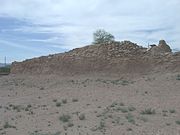

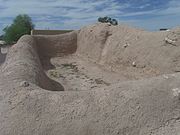

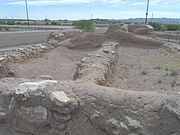


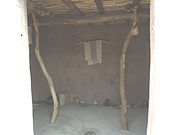
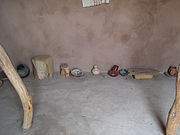
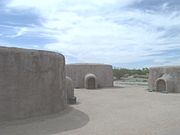
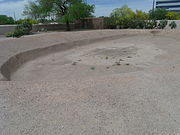


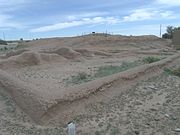
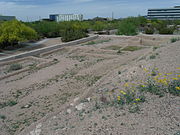





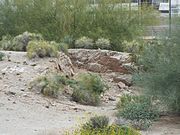
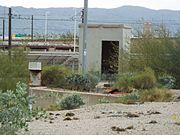
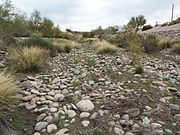

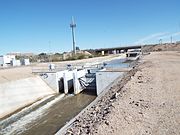

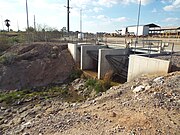
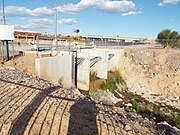
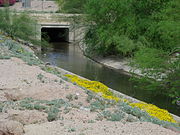

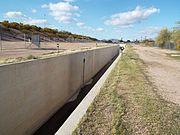


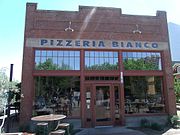




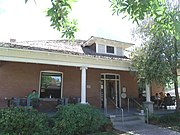

![What remains of the Phoenix Bakery building. The structure was built in 1881 and was originally located at 7 West Washington Street. The building was donated to the Pioneer Living History Museum in Phoenix. In 2019, the bakery was moved and reassembled at the Phoenix Zoo. [16]](http://upload.wikimedia.org/wikipedia/commons/thumb/2/2e/Phoenix-Pioneer_Living_History_Museum-Phoenix_Bakery-1881-1.jpg/180px-Phoenix-Pioneer_Living_History_Museum-Phoenix_Bakery-1881-1.jpg)
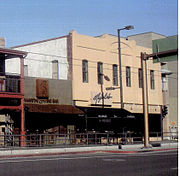
![The Steinegger Lodging House. The now abandoned structure was built in 1889 and listed in the National Register of Historic Places, reference: #86001369 on June 19, 1986. It was also known as the Alamo Hotel, St. Francis Hotel and the Golden West Hotel. It is located in 27 E. Monroe St. The Steinegger Lodging House was demolished on July 13, 2020.[17]](http://upload.wikimedia.org/wikipedia/commons/thumb/4/49/Px-Steinegger_Lodging_House-1875.jpg/180px-Px-Steinegger_Lodging_House-1875.jpg)




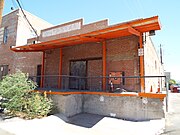
![Historic Prescott and Eastern Railroad Depot built in 1898 in Mayer, Arizona. The building was purchased by a private citizen who had it hauled to a hill in Phoenix. The owner turned it into part of his home. It is located at 1711 N. 18th Place.[18]](http://upload.wikimedia.org/wikipedia/commons/thumb/d/d8/Mayer-Prescott_and_Eastern_Railroad_Depot-1898-2.jpg/180px-Mayer-Prescott_and_Eastern_Railroad_Depot-1898-2.jpg)




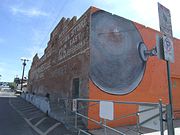


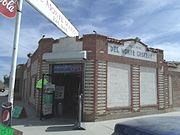
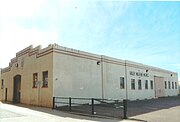

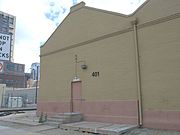


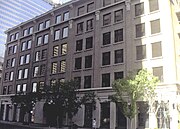

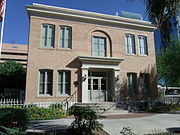
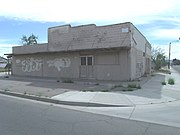

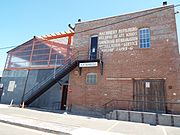

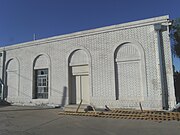
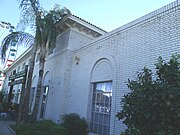
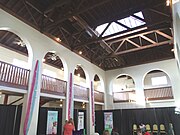
![The Tovrea Land and Cattle Co. Administration Building / Stockyards Restaurant is located at 5009 E. Washington St. In 1919, Edward A. Tovrea, the "Cattle Baron," opened his Phoenix packing house west of 48th Street and Van Buren to support his growing beef operations. The Tovrea Land and Cattle Co. had grown to nearly 40,000 head of cattle secured by 200 acres of cattle pens, making it the world's largest feedlot. In 1947, The Stockyards Restaurant officially opened and quickly became a favorite gathering place for cattlemen, bankers and politicians. Although cattle fortunes faded in the late 1950s and pens slowly gave way to urban growth, the popularity of Arizona's Original Steakhouse remained intact.[19] The property was listed in the Phoenix Historic Property Register in March 2004.](http://upload.wikimedia.org/wikipedia/commons/thumb/f/fa/Phoenix-Tovrea_Land_and_Cattle_Co._Administration_Building_-1919.JPG/180px-Phoenix-Tovrea_Land_and_Cattle_Co._Administration_Building_-1919.JPG)
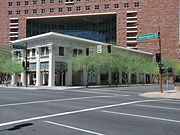

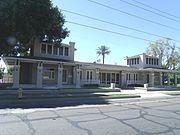



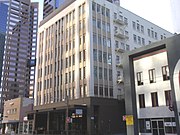

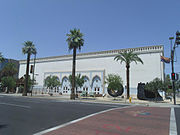




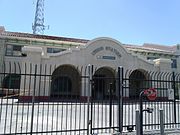

![The Brickhouse Warehouse Building was built in 1924 and originally served as a warehouse. The structure is located at 1 East Jackson Street on the original town-site of Phoenix.[20]](http://upload.wikimedia.org/wikipedia/commons/thumb/9/94/Phoenix-Brickhouse_Warehouse-1923-2.jpg/180px-Phoenix-Brickhouse_Warehouse-1923-2.jpg)

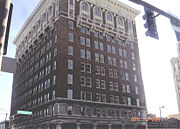
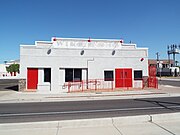
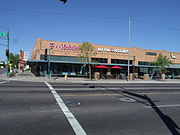




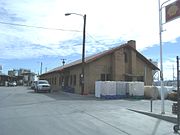
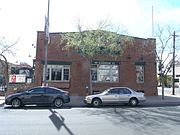

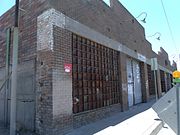
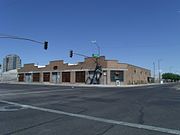



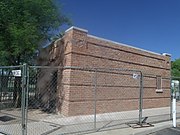
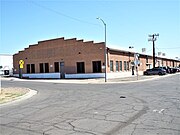






![The Welnick Arcade Grocery Store building was built in 1927 and is located at 324 Van Buren Street. The building was listed in the National Register of Historic Places on August 9, 2016, reference: #16000490.[20]](http://upload.wikimedia.org/wikipedia/commons/thumb/c/c4/Phoenix-Welnick_Arcade_Grocery-1927-1.jpg/180px-Phoenix-Welnick_Arcade_Grocery-1927-1.jpg)
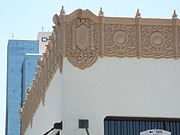



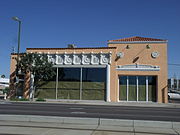
![The Gold Spot Shopping Center built in 1925 and located at 1001 N. 3rd Avenue. The building served as a Shopping Center and Grocery from 1925 to 1983. Now serves as a Marketing Center. The building is in the Roosevelt Historic District which was listed in the National Register of Historic Places on November 30, 1983, reference #83003490.[21]](http://upload.wikimedia.org/wikipedia/commons/thumb/b/b7/Phoenix-Gold_Spot_Shopping_Center-1925-2.jpg/180px-Phoenix-Gold_Spot_Shopping_Center-1925-2.jpg)

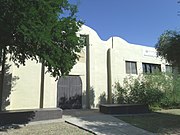
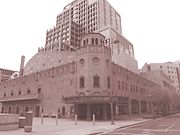










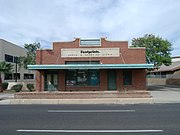




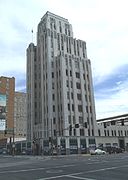

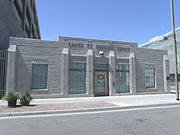
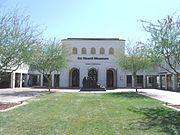



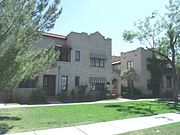
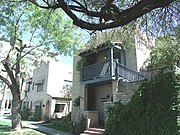






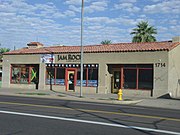
![This location which once housed the Living Room Lounge was built in 1930 and is located at 4007 E. Camelback Road in Phoenix. The building housed the Silver Poodle Cocktail Lounge prior to 1968, when boxing welterweight Tony DeMarco became the owner of the property and established what he called the Living Room Lounge. DeMarco no longer owns the property which now belongs to the U-Haul Co.[22]](http://upload.wikimedia.org/wikipedia/commons/thumb/2/2d/Phoenix-Tony_DeMarco%27s_Living_Room_Lounge-1930.JPG/180px-Phoenix-Tony_DeMarco%27s_Living_Room_Lounge-1930.JPG)





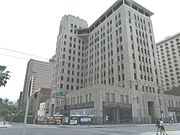
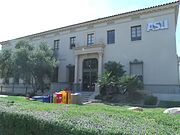



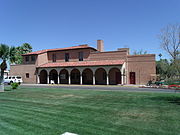



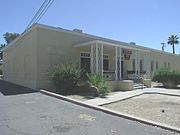

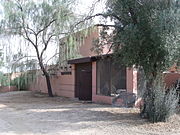
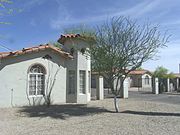
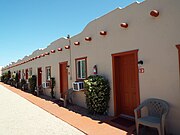










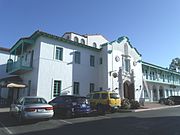
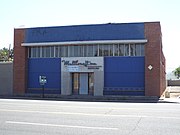


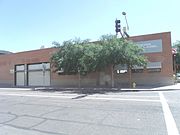


![The original Sky Harbor Air Traffic Control Tower was built in 1952 along with Terminal 1. Terminal 1 was demolished in 1991 and the truncated iconic control tower was moved to 2768 East Old Tower Road, where it is currently located.[23]](http://upload.wikimedia.org/wikipedia/commons/thumb/2/28/Phoenix-Sky_Harbor_Air_Traffic_Control_Tower_-1952-2.jpg/135px-Phoenix-Sky_Harbor_Air_Traffic_Control_Tower_-1952-2.jpg)
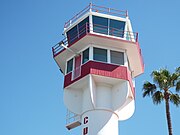
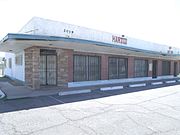

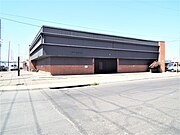





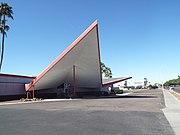
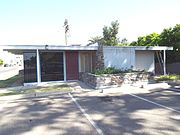




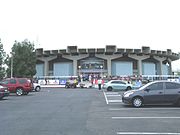

![Arizona Veterans Memorial Coliseum built in 1965 and located at and located at 1826 W. McDowell Road. The coliseum served as the home of the Phoenix Suns from 1968 to 1992. The Monkees performed there in 1967 and so did Elvis Presley in 1970 and 73.[24]](http://upload.wikimedia.org/wikipedia/commons/thumb/4/44/Phoenix-Arizona_Veterans_Memorial_Coliseum-1965-2.jpg/180px-Phoenix-Arizona_Veterans_Memorial_Coliseum-1965-2.jpg)
![Different view of the Arizona Veterans Memorial Coliseum. On February 2, 1980, boxing Hall of Famer, Salvador Sanchez won the WBC World featherweight title when he beat Danny Lopez. Both Pope John Paul II (Sept. 14, 1987) and Mother Teresa (1989) made appearances there. Among the U.S. presidents that have visited the coliseum are Richard Nixon and Barack Obama.[24]](http://upload.wikimedia.org/wikipedia/commons/thumb/b/b6/Phoenix-Arizona_Veterans_Memorial_Coliseum-1965-1.jpg/180px-Phoenix-Arizona_Veterans_Memorial_Coliseum-1965-1.jpg)

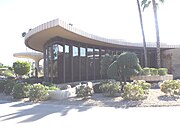
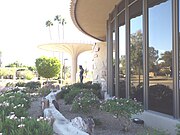
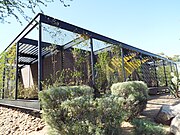




![The Brooks Memorial United Methodist Church was built in 1908 and is located on 5921 West Thomas Road. Since 1985, the old church has been used as a funeral home.[25]](http://upload.wikimedia.org/wikipedia/commons/thumb/a/a0/Phoenix-Brooks_Memorial_United_Methodist_Church_-1908-4.jpg/180px-Phoenix-Brooks_Memorial_United_Methodist_Church_-1908-4.jpg)




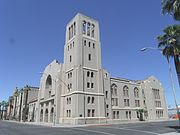
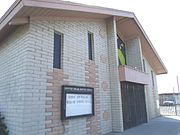
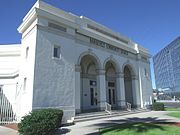
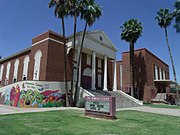
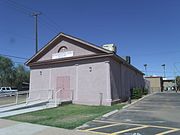


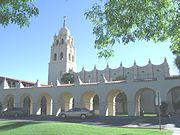
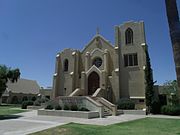
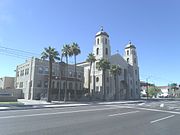

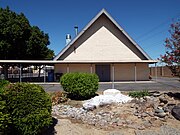







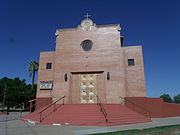


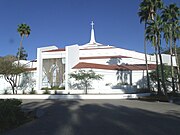

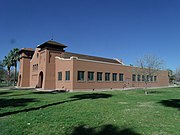

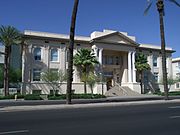

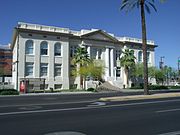


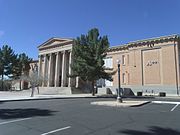


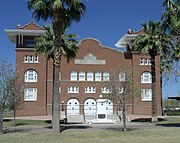
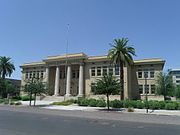



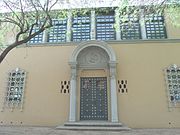



![North Phoenix High School, now North High School (1954), was built in 1939 and is located on 1101 East Thomas Road. This is the original building which was planned and financed through the New Deal Works Projects Administration and Public Administration funds.[27]](http://upload.wikimedia.org/wikipedia/commons/thumb/e/ec/Phoenix-North_Phoenix_High_School-1939.jpg/180px-Phoenix-North_Phoenix_High_School-1939.jpg)
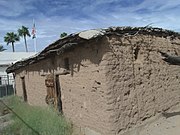










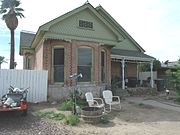

![The Clinton Campbell House belonged to Clinton Campbell, a locally prominent builder in Phoenix. It was built in 1895 and was located at 361 N. 4th Avenue. The house was listed in the National Register of Historic Places on January 12, 1995, reference #94001526. The historic house was demolished on September 15, 2017, by its owners.[28]](http://upload.wikimedia.org/wikipedia/commons/thumb/2/2d/Phoenix-Clinton_Campbell_House-1875.JPG/180px-Phoenix-Clinton_Campbell_House-1875.JPG)




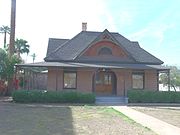




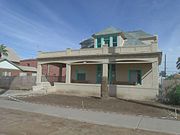
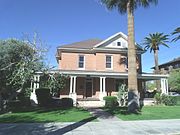


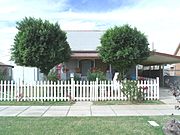








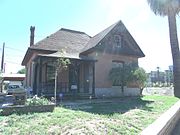



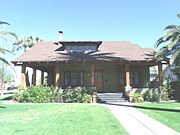
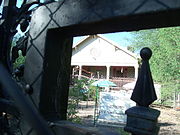


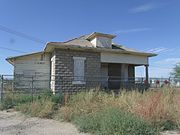

![The Meritt Farm House which was built in 1910 on 100 acres which John and Emma Meritt purchased in Phoenix. The house was donated to the Pioneer Living History Museum[30]](http://upload.wikimedia.org/wikipedia/commons/thumb/5/58/Phoenix-Pioneer_Living_History_Museum-Meritt_Farm-1910-1.jpg/180px-Phoenix-Pioneer_Living_History_Museum-Meritt_Farm-1910-1.jpg)
